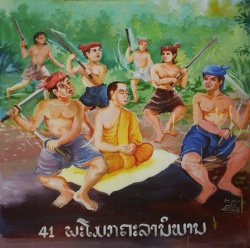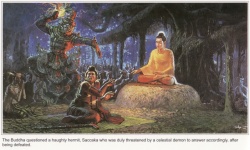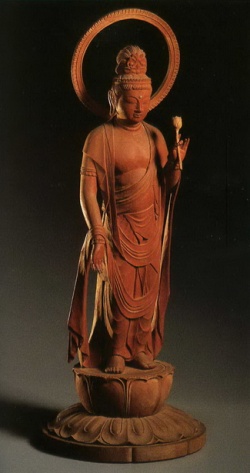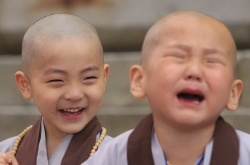Mahā Moggallāna Thera
The second of the Chief Disciples of the Buddha. He was born in Kolitagāma near Rājagaha, on the same day as Sāriputta (they were both older than the Buddha), and was called Kolita after his village. His mother was a brahminee called Moggalī (Moggallāni), and his father was the chief, householder of the village. Moggallāna's and Sāriputta's families had maintained an unbroken friendship for seven generations, and so the children were friends from their childhood. Sāriputta had five hundred golden palanquins and Moggallāna five hundred carriages drawn by thoroughbreds. One day the two friends went together to see a mime play (giraggasamajjā), and there, realizing the impermanence of things, decided to renounce the world. They first lived as disciples of Sañjaya, and then wandered all over Jambudīpa, discussing with all learned men, but finding no satisfaction. Then they separated, after agreeing that whoever first succeeded in finding what they sought should inform the other.
After some time, Sāriputta, wandering about in Rājagaha, met Assaji, was converted by him to the faith of the Buddha, and became a sotāpanna. He found Moggallāna and repeated the stanza he had heard from Assaji (ye dhammā hetuppabhavā, etc.), and Moggallāna also became a sotāpanna. The two then resolved to visit the Buddha at Veluvana, after an unsuccessful attempt to persuade Sañjaya to accompany them. Sañjaya's disciples, however, five hundred in number, agreed to go, and they all arrived at Veluvana. The Buddha preached to them, and ordained them by the "ehi bhikkhu pabbajjā." All became arahants except Sāriputta and Moggallāna. Moggallāna went to the hamlet of Kallavāla (for details see Pacala Sutta, A.iv.85f, where the village is called Kallavālamutta) in Magadha, and there, on the seventh day after his ordination, drowsiness overcame him as he sat meditating. The Buddha knew this, and appearing before him, exhorted him to be zealous. That very day he attained arahantship.
On the day that Sāriputta and Moggallāna were ordained, the Buddha announced in the assembly of monks that he had assigned to them the place of Chief Disciples and then recited the Pātimokkha. The monks were offended that newcomers should be shown such great honour. But the Buddha told them how these two had for a whole asankheyya and one hundred thousand years strenuously exerted themselves to win this great eminence under him. They had made the first resolve in the time of Anomadassī Buddha. Moggallāna had been a householder, named Sirivaddha, and Sāriputta a householder, called Sarada. Sarada gave away his immense wealth and became an ascetic. The Buddha visited him in his hermitage, where Sarada and his seventy four thousand pupils showed him great honour. Anomadassī's chief disciple, Nisabha, gave thanks, and Sarada made a vow that he would become the chief disciple of some future Buddha. Anomadassī saw that his wish would be fulfilled and told him so.
After the Buddha's departure, Sarada went to Sirivaddka, and, announcing the Buddha's prophecy, advised Sirivaddha to wish for the place of second disciple. Acting on this advice, Sirivaddha made elaborate preparations and entertained the Buddha and his monks for seven days. At the end of that time, he announced his wish to the Buddha, who declared that it would be fulfilled. From that time, the two friends, in that and subsequent births, engaged in good deeds. AA.i.84ff.; Ap.ii.31ff.; DhA.i.73f.; SNA.i.326ff.; the story of the present is given in brief at Vin.i.39ff.
Sāriputta and Moggallāna are declared to be the ideal disciples, whose example others should try to follow (E.g., S.ii.235; A.i.88). In the Saccavibhanga Sutta (M.iii.248) the Buddha thus distinguishes these "twin brethren" from the others: "Sāriputta is as she who brings forth and Moggallāna is as the nurse of what is brought forth; Sāriputta trains in the fruits of conversion, Moggallāna trains in the highest good. Sāriputta is able to teach and make plain the four Noble Truths; Moggallāna, on the other hand, teaches by his iddhi-pātihāriya." (BuA.31) Moggallāna's pre eminence lay in his possession of iddhi power (A.i.23). He could create a living shape innumerable times and could transfer himself into any shape at will. Thag.vs.1183; he is recorded as saying that he could crush Sineru like a kidney bean (DhA.iii.212), and, rolling the earth like a mat between his fingers, could make it rotate like a potter's wheel, or could place the earth on Sineru like an umbrella on its stand. When the Buddha and his monks failed to get alms in Verañjā, Moggallāna offered to turn the earth upside down, so that the essence of the earth, which lay on the under surface, might serve as food. He also offered to open a way from Nalerupu-cimanda to Uttarakuru, that the monks might easily go there for alms; but this offer was refused by the Buddha (Vin.iii.7; Sp.i.182f.; DhA.ii.153).
Several instances are given of this special display of iddhi. Once, at the Buddha's request, with his great toe he shook the Migāramātupāsāda, and made it rattle in order to terrify some monks who sat in the ground floor of the building, talking loosely and frivolously, regardless even of the fact that the Buddha was in the upper storey. See Pasādakampana Sutta, S.v.269ff.; also the Utthāna Sutta, SNA.i.336f.
On another occasion, when Moggallāna visited Sakka to find out if he had profited by the Buddha's teaching, he found him far too proud and obsessed by the thought of his own splendour. He thereupon shook Sakka's palace, Vejayanta, till Sakka's hair stood on end with fright and his pride was humbled (See Cūlatanhāsankhaya Sutta, M.i.251ff). Again, Moggallāna is mentioned as visiting the Brahma world in order to help the Buddha in quelling the arrogance of Baka Brahmā. He himself questioned Baka in solemn conclave in the Sudhammā-Hall in the Brahma world and made him confess his conviction that his earlier views were erroneous. Thag.vs.1198; ThagA.ii.185; S.i.144f. ; other visits of his to the Brahma world are also recorded when he held converse with Tissa Brahmā (A.iii.331ff.; iv.75ff.; cp. Mtu.i.54ff.).
In the Māratajjaniya Sutta (M.i.332ff) we are told how Māra worried Moggallāna by entering into his belly, but Moggallāna ordered him out and told him how he himself had once been a Māra named Dūsī whose sister Kālī was the mother of the present Māra. Dūsī incited the householders against Kakusandha Buddha and was, as a result, born in purgatory.
But, according to the Commentaries (E.g., ThagA.ii.188ff), Moggallāna's greatest exhibition of iddhi power was the subjugation of the Nāga Nandopananda. No other monk could have survived the ordeal because no other was able to enter so rapidly into the fourth jhāna; which was the reason why the Buddha would give permission to no other monk but Moggallāna to quell the Nāga's pride. Similar, in many ways, was his subjection of the Nāga who lived near the hermitage of Aggidatta (DhA.iii.242) (q.v.). Moggallāna could see, without entering into any special state of mind, petas and other spirits invisible to the ordinary mortal eye (See, e.g., DhA.ii.64; iii.60, 410f., 479; S.ii.254ff.; where he saw petas while in the company of Lakkhana; cp. Avadānas i.246ff.). He would visit various worlds and bring back to the Buddha reports of their inhabitants (see also Mtu.i.4ff. regarding his visit to the Nirayas), which the Buddha used in illustration of his sermons. The Vimānavatthu (see also DhA.iii.291, re Nandiya, and iii.314) contains a collection of stories of such visits, and we are told (S.v.366f) that Moggallāna's visits to the deva worlds - e.g., that to Tāvatimsa were very welcome to the devas.
Though Moggallāna's pre eminence was in iddhi power, yet in wisdom, too, he was second only to Sāriputta. These two could answer questions within the range of no other disciple of the Buddha (DhA.iii.227). The Buddha paid a compliment to Moggallāna's powers of preaching, when, having preached himself to the Sākyans in their new Mote Hall at Kapilavatthu, he asked Moggallāna, after their departure, to talk to the monks, as he himself was weary. And Moggallāna spoke to them of lusts and of the means of getting rid of them. At the end of the sermon the Buddha praised him warmly (S.iv.183ff). Mention is made elsewhere (S.iv.262-9) of eloquent sermons preached by him on the jhānas, on qualities which lead to true emancipation (A.v.155ff), and of visits paid to him by Sakka in company with numerous other gods in order to hear him preach. Other devas also went to hear him - e.g., Candana, Suyāma, Santusita, Sunimitta and Vasavatti (S.iv. 269 80). He was also consulted by those, such as Vacchagotta (E.g., S.iv.391ff), and Vappa (A.ii.196ff), eager to learn from him the teachings of the Buddha. When the Buddha went to preach the Abhidhamma in Tāvatimsa, it was to Moggallāna that he entrusted the task of preaching to the people who were waiting for his return. Moggallāna, therefore, provided for these people spiritually, while Anāthapindika looked after their bodily needs (DhA.iii.219). When the time drew near for the Buddha's return, Moggallāna, at the request of the people, went to Tāvatimsa, diving into the earth and climbing Sineru, in full view of them all, in order to find out what the Buddha intended doing, so that the people might be kept informed (DhA.224; J.iv.265; cp. Dvy.375). No task, which he might be told by the Buddha to perform, seemed to Moggallāna too insignificant. Thus we find him employed by the Buddha as messenger to the arahant Uggasena, telling him that the Buddha wished to see him (Ibid., iv.62). He was also sent to Sakkhara, to Macchariya Kosiya, to
check his miserliness and bring him to Jetavana (Ibid., i.369f.; J.i.347); and to Sīlavā, whom Ajātasattu was plotting to kill (ThagA.i.536). When Visakhā was building the Migāramātupāsāda and the Buddha was away on one of his journeys, Moggallāna, because of his iddhi power, and five hundred monks were left to supervise the work, which was carried through without difficulty (DhA.i.414f). The Buddha placed great faith in his two chief disciples and looked to them to keep the Order pure. There is one instance recorded of Moggallāna seizing a wicked monk, thrusting outside and bolting the door (A.iv.204ff.). Once, when a monk charged Sāriputta with having offended him as he was about to start on a journey, Moggallāna and Ananda went from lodging to lodging to summon the monks that they might hear Sāriputta vindicate himself (Vin.ii.236; A.iv.374).
Their fame had reached even to the Brahma world, for we find Tudu Brahmā singing their praises, much to the annoyance of the Kokālika monk (Kokalika had a great hatred of them - e.g., A.v.170ff.; SN., p. 231ff.; SNA.ii.473ff). When Devadatta created a schism among the monks and took five hundred of them to Gayāsīsa, the Buddha sent Sāriputta and Moggallāna to bring them back. They were successful in this mission (DhA.i.143ff.; see also DhA.ii.109f., where they were sent to admonish the Assajipunabbasukā). Kakudha Koliyaputta, once servant of Moggallāna and later born in a huge manomayakāya, had warned Moggallāna of Devadatta's intrigues against the Buddha, but the Buddha ignored this information carried to him by Moggallāna (Vin.ii.185; A.iii.122ff). When Rāhula, the Buddha's son, was ordained, Sāriputta was his preceptor and Moggallāna his teacher (J.i.161; see SNA.i.304f., where the account is slightly different. There Moggallāna is spoken of as Rāhula's kammavācāriya.). Moggallāna seems to have carried out diligently the charge laid on him by the Buddha of looking after the monks’ welfare. Among the verses, attributed to him in the Theragāthā, are several containing exhortations to his colleagues (Thag.vss.1146-9, 1165f ); some of the colleagues are mentioned by name - e.g., Tissa, Vaddhamāna and Potthila (Ibid., 1162, 1163, 1174f). Elsewhere (S.i.194f) mention is made of his living at Kālasilā, with a company of five hundred monks, watching over them and discovering that all were arahants. Vangīsa witnessed this and praised Moggallāna in verse before the Buddha.
The love existing between Moggallāna and Sāriputta was mutual, as was the admiration. Sāriputta's verses in praise of Moggallāna (Thag.vss.1178 81) are even more eloquent than those of Moggallāna in praise of Sāriputta (Thag.vss.1176). Their strongest bond was the love of each for the Buddha; when away from him, they would relate to each other how they had been conversing with him by means of the divine ear and the divine eye. E.g., S.ii.275ff.; Moggallāna elsewhere also (S.ii.273f.) tells the monks of a conversation he held with the Buddha by means of these divine powers. For another discussion between Sāriputta and Moggallāna, see A.ii.154f.
In the Mahāgosinga Sutta (M.i.212) we find them staying in the Gosingasālavana in the company of Mahā Kassapa, Ananda, Revata and Anuruddha, engaged in friendly discussion, referring their conclusions to the Buddha for his opinion. Sāriputta, Moggallāna, and Anuruddha are again mentioned (S.v.174f., 299) as staying in the Ketakīvana in Sāketa. Among discussions between Anuruddha and Moggallāna is recorded one in which Anuruddha speaks of the value of cultivating the four satipatthānas (S.v.294f). It seems to have been usual for Sāriputta and Moggallāna, in their journeys, to travel together at the head of the monks, and lay disciples, who gave alms to the monks, were anxious to include them in their invitations. Velukandaki in Dakkhinagiri (A.iii.336; iv.63); and Cittagahapati in Macchikāsanda (DhA.ii.74f.).
Moggallāna died before the Buddha, Sāriputta dying before either. The Theragāthā contains several verses attributed to Moggallāna regarding Sāriputta's death (vs.1158 61). Sāriputta died on the full moon day of Kattika and Moggallāna two weeks later, on the new moon day (SA.iii.181).
According to the Commentaries (J.v.125ff) his death resulted from a plot of the Niganthas. Moggallāna used to visit various worlds and return with his report that he had discovered that those who followed the Buddha's teaching reached happy worlds, while the followers of the heretics were reborn in woeful conditions. These statements diminished the number of the heretics and they bribed brigands to kill Moggallāna. They surrounded the Elder's cell in Kālasilā, but he, aware of their intentions, escaped through the keyhole. On six successive days this happened; on the seventh, they caught him and beat him, crushing his bones and leaving him for dead. Having recovered consciousness, with a great effort of will, he dragged himself to the Buddha in order to take his leave, and there he died, to the sorrow of the deva worlds. This sad death is said to have been the result of a sin committed by him in a previous birth. Acting on the instigation of his wife, he had taken his blind parents into a forest, where, pretending that they were attacked by thieves, he had beaten them to death. For this deed he suffered in hell for innumerable years, and in his last birth lost his life by violence.
The account in DhA.iii.65ff. differs in several details. The thieves tried for two months before succeeding in their plot and, in the story of the past, when the blind parents were being beaten, they cried out to the supposed thieves to spare their son. Moggallāna, very touched by this, did not kill them. Before passing into Nibbāna, he preached to the Buddha, at his request, and performed many miracles, returning to Kālasilā to die. According to the Jātaka account his cremation was performed with much honour, and the Buddha had the relics collected and a Thūpa erected in Veluvana.
Moggallāna's body was of the colour of the blue lotus or the rain cloud (Bu.i.58). There exists in Ceylon an oral tradition that this colour is due to his having suffered in hell in the recent past!
Moggallāna is connected with characters in several Jātakas: thus, he was
Kisavaccha in the Indriya Jātaka (J.iii.469),
Sakka in the Illīsa (i. 354),
one of the devas in the Kakkāru (iii.90),
the tortoise in the Kurungamiga (ii.155),
Candasena in the Khandahāla (vi. 157),
the senāpati in the Cullasutasoma (v. 192),
the youngest bird in the Javanahamsa (iv. 218),
the elephant in the Tittira (i. 220),
the tiger in the Tittira (iii.543),
Ayura in the Dasannaka (iii.341),
the jackal in the Pañcūposatha (iv. 332),
Suriya in the Bilārikosiya (iv. 69),
one of the brothers in the Bhisa (iv. 314),
Subhaga in the Bhūridatta (vi. 219),
the old tortoise in the Mahāukkusa (iv. 297),
Migājina in the Mahājanaka (vi. 68),
Bījaka in the Mahānāradakassapa (vi. 255),
the king's charioteer in the Rājovāda (ii.5),
the tiger in the Vannāroha (iii.193),
the Garula king in the Vidhurapandita (vi. 329),
the tiger in the Vyaggha (ii.358),
the rat in the Saccankara (i. 32),
Bhadrakāra in the Sambhava (v. 67),
Kisavaccha in the Sambhanga (v. 151),
the jackal in the Sasa (iii.56),
Canda in the Sudhābhojana (v. 412), and
Gopāla in the Hatthipāla (iv. 491).




